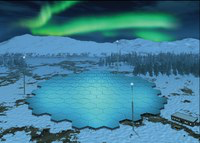Intensifying collaboration on the EISCAT_3D eInfrastructure
On 5 November 2015, the NeIC EISCAT_3D Support (E3DS) project hosted a meeting in Stockholm, where stakeholders from the Nordic countries gathered to update one another on the status of EISCAT_3D, the progress of the E3DS project and the eInfrastructure roadmaps of providers of network, storage and computing resources.

|
| EISCAT_3D. Photo: National Institute of Polar Research, Japan (NIPR) |
The international research infrastructure EISCAT_3D is a three-dimensional imaging radar that will be located in the northernmost part of Europe. It will take continuous measurements of the geospace environment and its coupling to the Earth’s atmosphere. The radar system is designed to investigate how the Earth’s atmosphere is coupled to space, but it will also be suitable for use for a wide range of other scientific aims.
The objective of the meeting in Stockholm was also to intensify collaboration between the stakeholders to make the best use of existing expertise in designing and implementing the complex distributed eInfrastructure for EISCAT_3D.
EISCAT_3D needs and resources
The needs of EISCAT_3D and available resources were discussed at the meeting. First, EISCAT’s Ingemar Häggström and Anders Tjulin updated the participants on the current funding situation and implementation plan, relationships to other projects in the European context and the status of the radar sites. Next, EISCAT_3D Support project manager John White presented the progress of the NeIC project, focusing in particular on the requirements for on-site computing (at the radar sites), the operations centre and the overall network. Then, the network providers NORDUnet, SUNET (Börje Josefsson), UNINETT (Vidar Faltinsen) and FUNET (Juha Oinonen) jointly laid out their plans for upgrading the Nordic and national networks, addressing in particular the situation at the planned radar sites. It was found that EISCAT_3D does not require dedicated point-to-point links, which may simplify network planning and reduce construction costs as well as provide more flexibility for selecting sites for the EISCAT_3D operations centre, data centre and archives. In addition, the general availability of 100 Gbit/s may ease some design decisions, and the potential upgrade to 400 Gbit/s may open up for more demanding science cases. Finally, CSC (Janne Ignatius), SNIC (Jacko Koster) and UNINETT Sigma2 (Gunnar Bøe) described the resources and services they current offer and their plans for upgrading these in the near future. They also discussed their wide range of experience in designing, implementing and operating distributed eInfrastructures.
The talks were complemented by a presentation of the Nordic Tier-1 eInfrastructure (Mattias Wadenstein) which illustrated the components that may be re-used by EISCAT_3D and a presentation of the HPC services at UiT The Arctic University of Norway (Roy Dragseth).
Conclusions
The meeting was chaired by NeIC director Gudmund Høst and concluded with agreement on specific near- and mid-term actions:
- The NeIC EISCAT_3D Support project will refine the requirements for the EISCAT_3D network, including alternative sites for the operations centre, data centre and archives. The network providers will then provide a detailed analysis of construction time as well as of construction and operation costs.
- The NeIC EISCAT_3D Support project will seek advice from the national eInfrastructure providers on various issues related to gathering requirements, designing solutions and identifying the work packages and IT expertise needed for implementing the eInfrastructure.
- In the future, general stakeholder meetings (like this one) should be held about once a year and component/technology-oriented meetings should be held as necessary.
